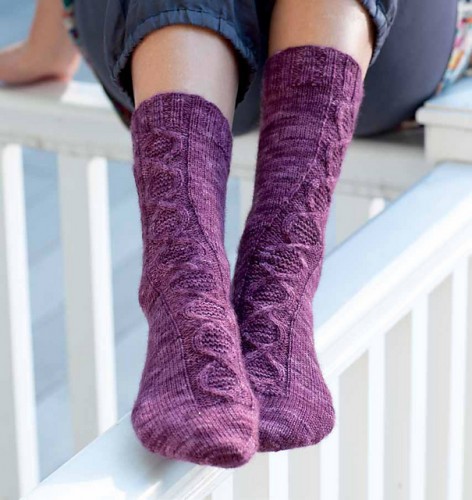Just in case I haven’t kept you busy enough with sock patterns, here are some sock patterns I contributed to books that have come out in the past year.
First of all, I am excited about  The Knitter’s Book of Socks by Clara Parkes, author of The Knitter’s Book of Yarn and The Knitter’s Book of Wool.Â
Clara Parkes spends a significant portion of the book discussing the various pros and cons of all different types of sock yarns, focusing on how twist, ply, and fiber content work together to create elasticity, durability, moisture management, and stitch definition. If you’ve read her other two books on yarn and wool, some of the ideas here will be familiar to you. However, the specific application of all this knowledge is really valuable when it comes to making socks that behave just the way you want them to.
The remainder of the book features 20 sock patterns. The patterns are organized by technique, starting with simple ribbed and textured patterns and moving on to cables, lace, colorwork, and slipped and twisted stitches. There are 15 top-down socks and 5 toe-up patterns to choose from.
See all the patterns from The Knitter’s Book of Socks on Ravelry here.
In Elm, I used a careful pairing of increases and decreases within a simple rib motif to create the illusion of smooth, overlapping branches. While the pattern has less elasticity than a straightforward k2, p2 rib, there’s still sufficient stretch for a comfortable fit. The socks were knit in String Theory Caper Sock, a hand-dyed merino-cashmere-nylon blend that’s become a sock club favorite.
For so many knitters, knitting is definitely a family affair. My Grandmother’s Knitting by Larissa Brown celebrates the passing on of these crafting traditions and honors the influence of those who’ve come before us with 21 patterns and 17 family stories. It’s always interesting to learn how people got their start in knitting or designing.
See all the patterns from My Grandmother’s Knitting on Ravelry here.
My family history is complicated, with lots of travel around Asia and the United States. The curved lines on these socks represent their journeys. I named the Wan Jai socks after my grandmother, whose name translates to ‘sweet heart’ in English. These socks were knit in Zen Yarn Garden Serenity 20, a beautiful and soft merino-cashmere-nylon blend.
 Sock Knitting Master Class by Ann Budd is a wonderfully complete sock technique book. Inside, there’s information on all the different cast-ons and bind-offs that are good to use for socks (8 and 7 of them, respectively) as well as 6 different heels and 5 different toes.
It features 10 top-down patterns and 7 toe-up ones. Nearly every possible technique is featured: cables, lace, stranded colorwork, entrelac, twisted stitches, intarsia, shadow knitting, replaceable soles, traveling stitches, stripes – there’s something for everyone. Many of the patterns have multiple sizes and Clara Parkes has written helpful notes on every yarn featured in the book.
See all the patterns from Sock Knitting Master Class on Ravelry here.
I contributed the Asymmetrical Cables socks. The semi-solid color and texture of the Pagewood Farm St. Elias yarn I chose for these socks called for a bold pattern, so I decided to knit hefty yet simple cable panels with garter-stitch interiors. Each sock has a stockinette background that showcases the movement of the cable panels. The panels start out in parallel on the side of the leg, then they diverge as one panel swoops across the front of the leg and the top of the foot to create an elegant visual line.








